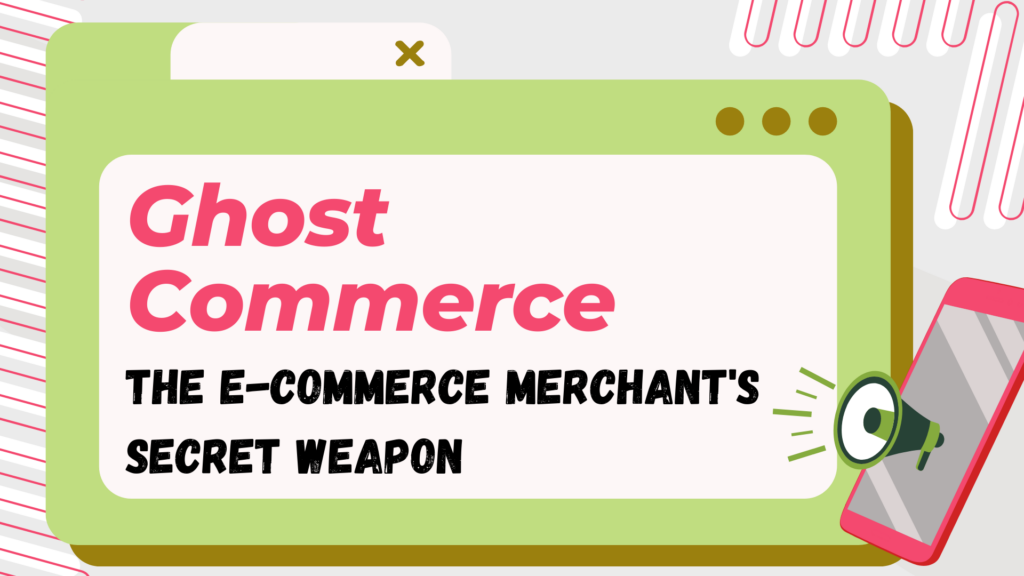A lot of people are wondering if dropshipping is dead or not. Well, let’s take a look. Recent facts and figures show that the global dropshipping market can reach around $476.10 Billion by 2026. Is ghost commerce something worth trying?
This increase in the market is driven by rapid advancements in tech and business strategies. One example of such advancements is ghost commerce. This is a new way to market our products online.
The best part? We do not have to take ownership of products. Ghost commerce can help sell products and make money fast. But, there are a few ghost commerce challenges we need to think about beforehand.
In this article, we’ll focus on learning about what ghost commerce is. We’ll talk about how to use it to sell products on Shopify. But that’s not all. We’ll even cover the pros and cons of ghost commerce.
So, let’s get started.
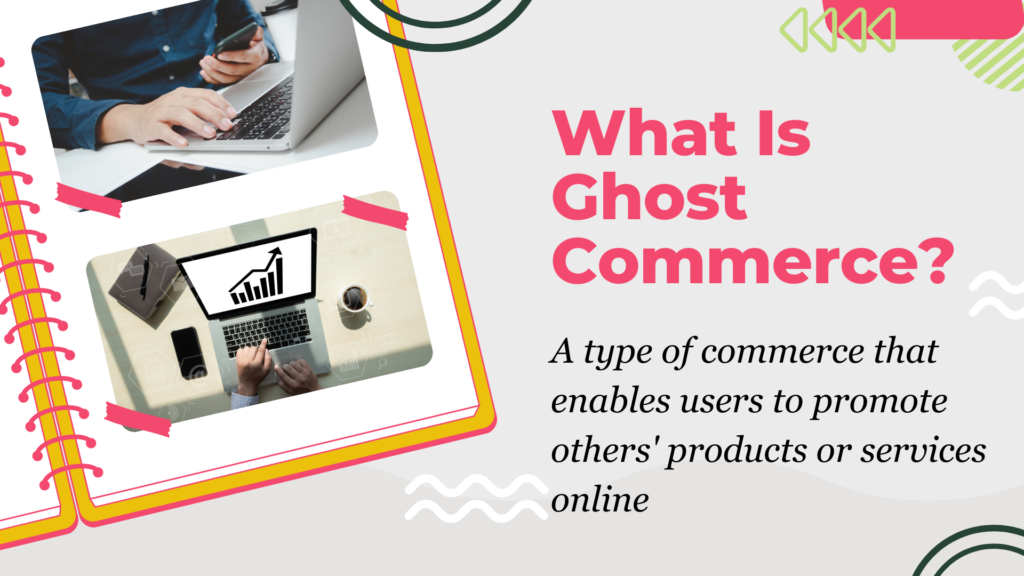
What Is Ghost Commerce?
A lot of us have heard the phrase ghost commerce. But do we really know what it means? Ghost commerce is quite a popular way of making income. We do not have to own any products or provide any services.
This type of commerce enables us to promote others’ products or services online. Sounds pretty similar to affiliate marketing, doesn’t it? Well, that’s because it is. With ghost commerce, all we have to do is set up a blog, website, or social media page.
Once our platform is up and running, we can add links to others’ products or services. Anytime a buyer clicks on the link and buys something, we get a commission. The model seems pretty simple, right?
In a ghost commerce business model, we basically act as the “middleman.” Our job is just to connect the customer with the right product or service. So, basically, we’re the solution provider working to create a win-win situation.
But what if we’re on the opposite end? Well, in that case, first, we can use tools to find the right products for our online commerce store. Then we can pay someone who has a ghost commerce platform to promote our products.
We can choose to give them an upfront payment or create a commission-based payment plan. Alright, so now that we have a firm grip on the topic, let’s look at how we can get started with ghost commerce.
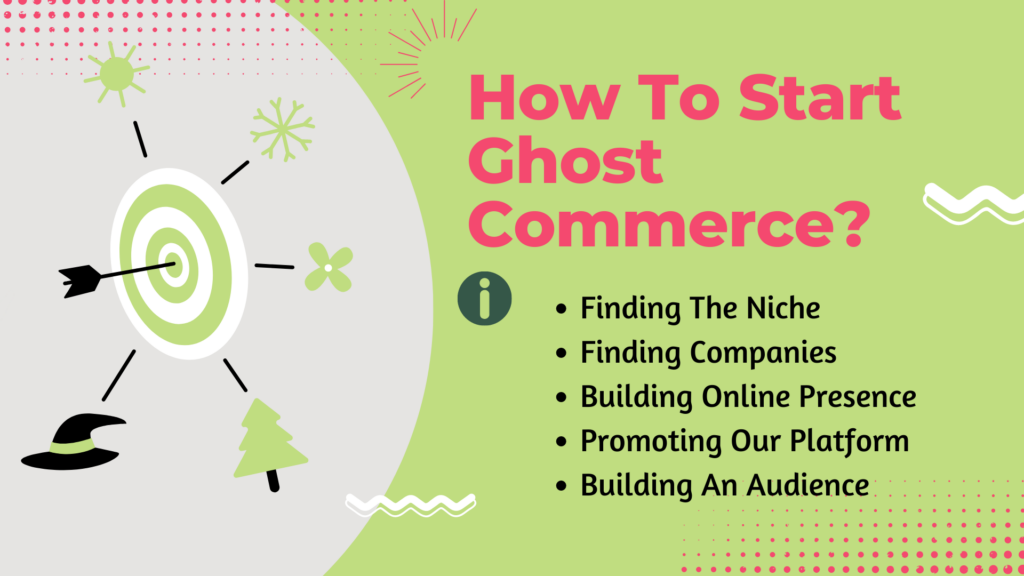
How To Start Using Ghost Commerce?
Most people often think that they’ve got the gist of ghost commerce and that it’s a straightforward business model. That might be true to a certain extent, but there are a few things we need to learn before starting on our ghost commerce journey.
Commerce has always revolved around what the customer wants. That hasn’t changed in the age of the internet. So, before we start ghost commerce and look to sell products, we need to learn who our potential customers are.
But that’s not all. We also need to figure out what types of products we plan to sell or promote, what online platforms we’ll use, and how we’ll create a brand. So with that in mind, let’s look at the exact steps you need to follow to start ghost commerce.
-
Finding The Niche
When we start out in commerce, the first thing we need to do is find our niche. We must know our target market inside out. This will help us figure out customer pain points.
We can then use this knowledge to find suitable products for our target audience. For those who’re wondering, “How to find a niche?” The answer is market research. We use tools like Google Trends for Dropshipping ideas and SEMRush for keyword and competitor research to learn more about our customers.
This will help us pinpoint what they want. It can also help identify the demand for specific products and competitors already doing business in that niche. Using all these insights, we can decide which products or niches we want to pursue.
-
Finding Companies
Once we’ve figured out what we want to sell or promote, we need to find companies that offer such products. This step might seem pretty simple at first, but there are quite a few things that we need to consider beforehand.
The product supplier we choose must be willing to readily ship the items we want. Any delays here can ruin the customer experience. But that’s not all. We also need to test items from different companies.
This will help us make sure that the products address the customer’s pain points. Lastly, we need to see how much the company pays to promote its products or how much money we make if we sell an item.
-
Building Online Presence
Next, we need to build our online presence. We can use different social media platforms like Facebook or Instagram and can even create our own website. When choosing a platform, it’s better to pick one we’re most comfortable with.
But we also need to think about if that platform has a relevant audience. For example, if we want to sell fashion-related products, we can choose Instagram. That’s because the platform has tons of fashion lovers.
There are more than 64 million influencers on Instagram. We can even use them to promote our products. When we’re building an online presence, we need to be active on the platform.
This means sharing content on a regular basis. The content we share must add value to audiences. It can be anything. Product demos, testimonials, guides, and more. This will help us engage with our audience and will allow us to build competence.
This video can be of great help for beginners:
-
Promoting Our Platform
Today, nearly 4.8 billion people use social media. This means that simply creating an online presence won’t help us sell anything. We need to promote our presence. There are many ways of doing this.
We can use organic methods like search optimization and influencer outreach. We can also use paid methods like Facebook and Google Ads. But we need to consider a few things before we hit the “promote” button.
Our organic and paid promotions must be targeted to the right audience. Also, we need to have the objectives for our promotion efforts. There’s no point pouring money into ads if we don’t know where we’re going and the ads reach the wrong person.
-
Building An Audience
If we do our promotions the right way, chances are, we’ll build a fan following pretty quickly. But it doesn’t really mean that our job is done. Don’t forget, the more, the merrier.
So, we can’t just stop after the first few campaigns. We need to keep building an audience. But, we must understand that building an audience is more than just promoting our page.
We also need to keep the followers and visitors engaged. This means posting content, commenting, and replying to messages. This way, we’ll have a meaningful connection with our followers, and they will be more likely to buy from us.
And that right there is pretty much all you need to know to start ghost commerce. Now, some of us might not need to find suppliers or companies for products. That’s because we already have our Shopify store set up.
But this doesn’t mean that we can’t use ghost commerce. We can still use it to promote our own products. In fact, it’s one of the easiest ways to make money online. Let’s see how we can use ghost commerce with Shopify.
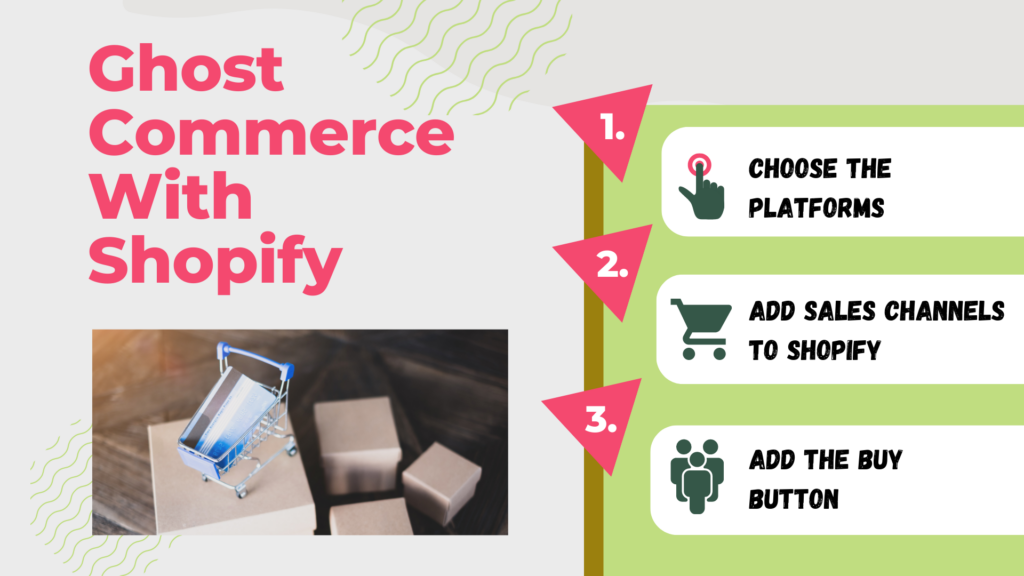
Ghost Commerce With Shopify
As mentioned, ghost commerce is basically when we create an online platform and use it to sell products and services. This is a great way to make money. It allows us to promote our products to audiences beyond Shopify.
Shopify is an e-commerce platform that allows us to create and manage online stores. It has tons of tools, features, and resources we can use to make money. It allows us to use third-party sales channels to promote and sell our products.
And that’s where ghost commerce comes in. We use our online presence on social media and our website to promote and sell our Shopify products. This allows us to earn more than the average Shopify store.
So, let’s look at how we can use the ghost commerce business model with Shopify.
-
Choose The Platforms
When we dive into building our online presence, we’ll realize some platforms are better than others. These are the platforms we need to use for our Shopify store. But we can’t just simply pick and choose here.
We need to see which platforms have the most suitable audience. We need to see how our ads perform, and we also need to look at the number of followers we have. Based on this, we can decide which social media platform we will use.
These factors will also help us figure out if our website is a good sales channel or not. Once we have our final picks, we can add these sales channels to our Shopify store. This process is a bit technical, but we can follow the steps below to get the job done.
-
Add Sales Channels To Shopify
Sales channels represent different platforms where we sell our products. Once we connect sales channels to Shopify, we can reach more people and make money like never before. We’ll even track our products, customers, and orders in one place. To add sales channels, follow these steps.
-
- Log in to Shopify
- Now, hover over to the “SALES CHANNEL” section in the left-hand side menu.
- Here we can find the sales channels that we’re already using. This includes our Shopify store, any point of sales (POS) system we use, and other platforms. Shopify has a lot of sales channels we can add. Some of them include Facebook, Google, and Pinterest.
- Next, click on the “Plus” icon next to “SALES CHANNEL.”
- Now a popup window will open. Here you will find all the available sales channels.
- To proceed, simply click on the “Plus” icon or click on the name of the sales channel for additional details and then click “Add Channel.”
- If the sales change we want to add is not available, we need to click on the “Visit Shopify App Store” option.
- If our store isn’t eligible for a sale channel, it will be listed under the “UNAVAILABLE” section. If we want to know why our store isn’t available, we can click on the “You can’t add this channel” option to learn more.
- Now, go back to the “SALES CHANNEL” section, click the channel’s name to open it, and complete the setup by linking to the Shopify store.
Once the sales channel has been connected to our Shopify store, all the products we have are automatically available on the channel. We can also use the “Buy Buttons” feature to sell products on our website or blog.
-
Add The Buy Button
We can add Buy Buttons to our website or blog. This helps our readers see what we have to offer and makes it easier for them to buy it. The Buy Buttons we add help show the product picture, details, and prices.
But that’s not all. If our readers want to buy products, they can do it using the Buy Button. They don’t even have to leave our website or blog. Isn’t that amazing? Let’s look at how we can add Buy Buttons.
-
- Click the “Settings” option and then go to “Apps and sales channels.”
- Now, click “Shopify App Store.”
- After accessing the app store, search for “Buy Button.”
- If we want to know more, we can always read the details.
- To proceed, click “Add channel.”
- Once the Buy Button sales channel has been added to our store, we can create a new Buy Button.
- Go back to the “Apps and sales channels” page.
- From here, click “Buy Button” and then click “Open sales channel.”
- Now, click “Create a Buy Button” and then choose the “Product Buy Button” option.
- After that, choose a product from the catalog and then click “Select.”
- We can also choose to select all the variants of a product or a single option. After that we can, we can change the button’s appearance and action.
- Once finalized, click “Next,” then click the “Copy code” option.
Now, we can add the Buy Button to our website or blog. To do this, we will need to open the HTML editor for our website. Then we can just paste the code where we want to add the button and save the changes.
And that’s all. Now our readers will be able to buy products directly from our blog. We can also create Buy Buttons for our entire Shopify collection. To do this, we’ll need to click on the “Collection Buy Button” option when creating a button.
Using ghost commerce can help us make money like never before. But, there are a few ghost commerce challenges we need to consider beforehand. For example:
- Increased competition due to low barriers to entry has become the most common ghost commerce challenge that we might face.
- Lack of control is another ghost commerce challenge we might face if we’re selling other people’s products.
- Winning over customer trust is another ghost commerce challenge that we might face as customers can’t judge the quality of the products.
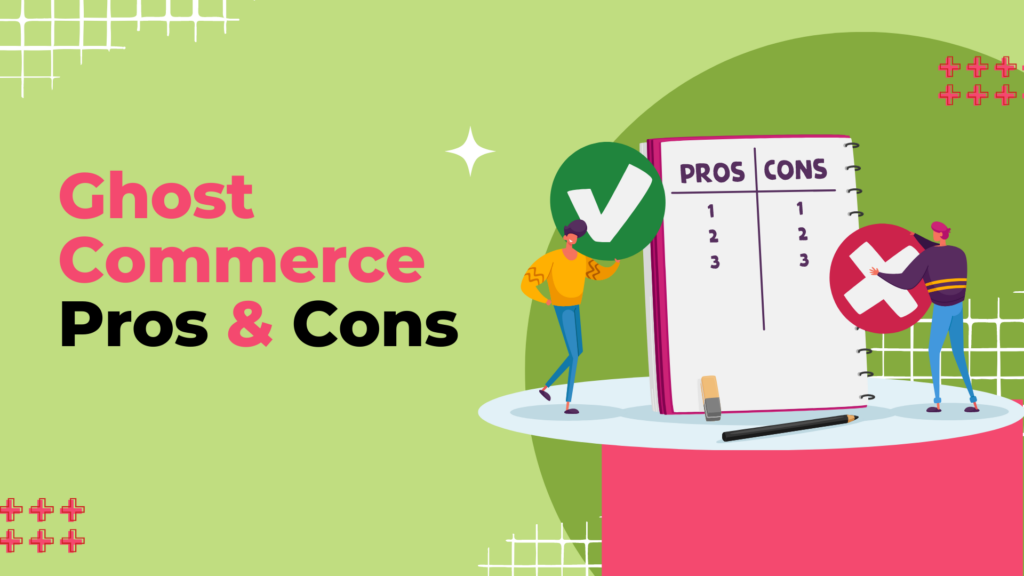
Ghost Commerce Pros & Cons
Now we know all there is to know about ghost commerce and how we can use it with Shopify. But we’re not done just yet. We still have to look at the pros and cons. Ghost commerce is becoming very popular.
It has a lot of benefits to offer. It allows us to reach more people. We can use the model to sell more and make money faster. But it does have a couple of drawbacks. Since a lot of people are using it, the competition is high. Let’s look at these pros and cons in more detail.
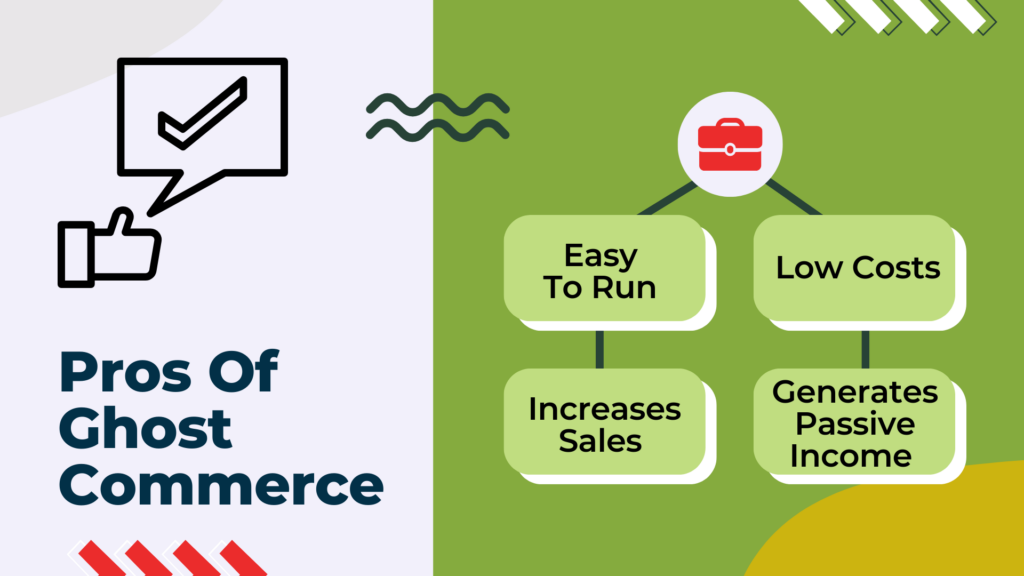
-
Pros Of Ghost Commerce
The ghost commerce model has tons of different advantages. We can use it to sell both our and other people’s products. Some of the pros of this commerce model include:
-
Easy To Run
This commerce model is one of the simplest ways to make money online. Think about it, we don’t need a physical store. We don’t even need an online one. We can just set up social media pages and a website. After that, all we have to do is promote and sell other people’s products for profit.
-
Low Costs
When most think about starting a business, the initial costs are the first thing that comes to mind. But, with ghost commerce, that’s not a problem. We create social media pages for free and host our website at cheap prices. So, the only costs we need to worry about are the ads and the internet bill.
-
Increases Sales
When we use a ghost commerce model with our Shopify store, we can increase our sales. Without this model, our customers can only buy from us on Shopify. But if we use the ghost commerce model for our Shopify store, we can add more channels. We can sell using Facebook, Pinterest, and our own website.
-
Generates Passive Income
Believe it or not, this commerce model can help us make passive income. We might need to put in a little effort at first. But when things get up and running, we can rest back and relax. Our ads will drive traffic to our website, and readers will buy products from there. We won’t even have to lift a finger to make money.
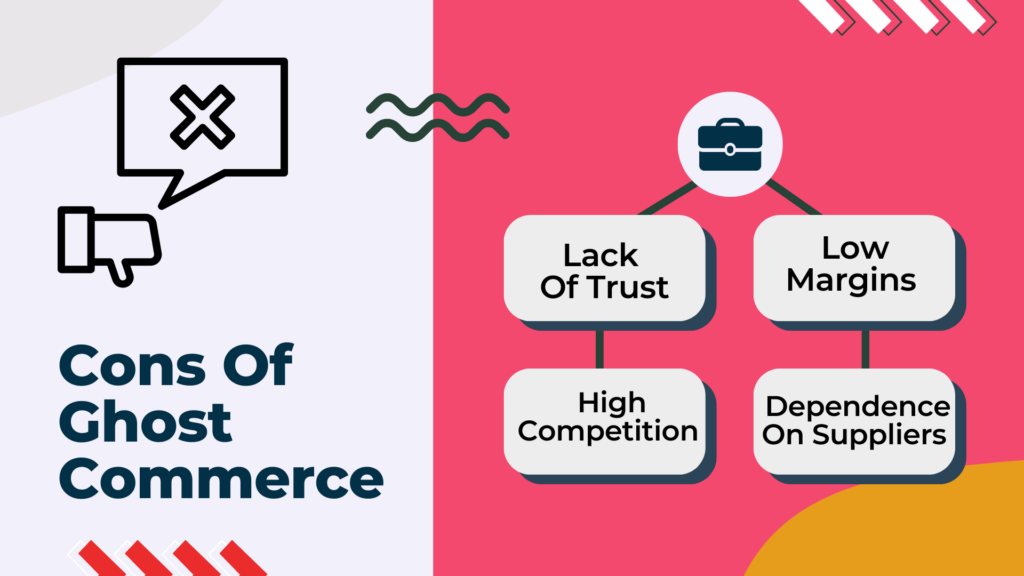
-
Cons Of Ghost Commerce
The ghost commerce models have a lot to offer. But, it does come with a few challenges. It’s important to know that these challenges can turn into drawbacks if not addressed. Some of the cons of ghost commerce include:
-
Lack Of Trust
When we start with different platforms, we have to build an audience. This means that we don’t have loyal customers from day one. Since our audience doesn’t know who we are, they can’t connect with us, and they can’t trust us. This is a common ghost commerce challenge that we might face in our early days.
-
Low Margins
As a ghost commerce seller, we only get a commission for what we sell. This means that our profit margins might be low. But, this drawback is not a deal breaker. This ghost commerce challenge can be addressed easily. All we do is set up our own Shopify store. This way, we won’t work for commission and can increase our profit margins.
-
High Competition
As mentioned, ghost commerce is becoming more and more popular. This means that competition in this commerce space is quite high. When we start out, we might feel overwhelmed by the tough competition. But, this ghost commerce challenge can be solved if we improve our ad campaigns and engage with our audience, as it will help us stand out.
-
Dependence On Suppliers
We are likely to face this ghost commerce challenge if we rely on promoting other people’s products. When we do that, we don’t really have control over what we’re selling. This can create problems if we have customers with pending orders and suppliers with nothing to deliver.
Before we choose to start in this commerce space, we need to check the pros and cons to make sure it’s right for us. This helps make sure we don’t run into unexpected problems and will allow you to make money online.
Conclusion
The ghost commerce business model is a great way to make money online. It’s pretty similar to affiliate marketing. Using this model, we can promote and sell other people’s products for a fee or commission. We can also use this commerce model to make our Shopify store more profitable.
When we use ghost commerce with Shopify, we can add multiple sales channels to our online store. This way we can reach more people and sell our products faster. The ghost commerce model has many benefits, like low costs and increased sales. But we need to consider some of its drawbacks as well to make the best decision.
Frequently Asked Questions (FAQs)
-
What is ghost commerce?
Ghost commerce is when we sell products that we don’t directly own. We basically act as the middleman and promote popular products on our platforms.
-
Can I use the ghost commerce model with Shopify?
Yes, Shopify allows us to add multiple sales channels to our store, so we can use the ghost commerce model with Shopify to increase awareness and sales.
-
Is ghost commerce expensive?
No, the ghost commerce business model is actually very affordable. Some of the costs we have to pay include website hosting, internet bills, and ad fees.

